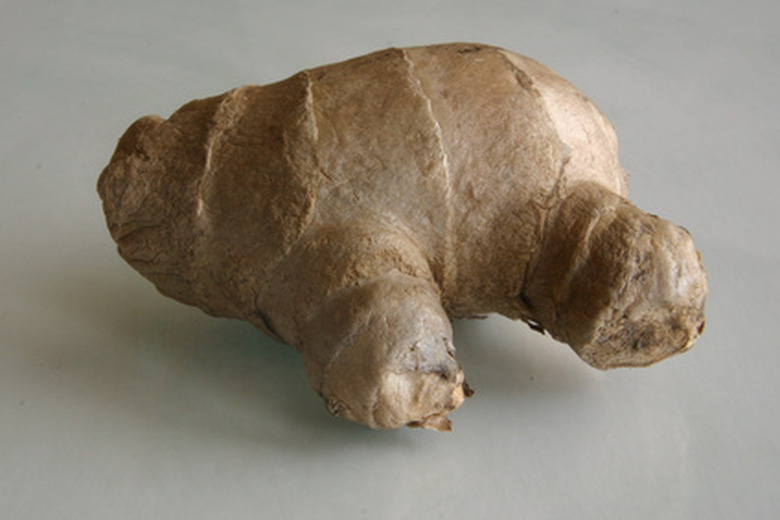The Life Cycle Of Ginger Plants
The spice ginger comes from the fleshy or dried, pulverized roots of Chinese ginger (Zingiber officinale). A tropical perennial herb native to Tropical Asia, it was first introduced into Europe over 2000 years ago. Seasonally dormant in the dry winters, it does not tolerate frosts or subfreezing soil temperatures. The plant has been in cultivation for so long that botanists consider ginger a cultigen, a term reserved for plants so genetically manipulated throughout history that its precise origins remain obscure, according to Kirsten Llamas, author of "Tropical Flowering Plants." You can grow ginger outdoors in U.S. Department of Agriculture hardiness zones 9 and warmer.
Germination
The ginger plant, through millennia of human cultivation, rarely flowers to produce viable seeds, if at all. A seed would germinate in the warm, organic-rich, moist soils of spring or summer, sending out a root and one embryo leaf to the bright light above the soil's surface.
- The spice ginger comes from the fleshy or dried, pulverized roots of Chinese ginger (Zingiber officinale).
- The plant has been in cultivation for so long that botanists consider ginger a cultigen, a term reserved for plants so genetically manipulated throughout history that its precise origins remain obscure, according to Kirsten Llamas, author of "Tropical Flowering Plants."
Seasonal Growth
Once growing, the ginger sends up firm stems from the rhizome root. The stems bears widely spaced long oval-lanced, green leaves with parallel veins. Stems reach a maximum height of nearly 6 feet over the course of the tropical summer when rainfall is abundant. Underground, the initial germination root begins to swell, storing sugars and starches created by the foliage during photosynthesis. This rhizome, or horizontal stem, develops a smooth tan skin with numerous lobes or knobs. From the tips of these lobes emerges new stems, effectively becoming new "plantlets" and creating a clump of stems in one ginger plant.
Flowering
Established, undisturbed ginger plants may produce flower stalks with dense flower clusters called an inflorescence anytime during the summer rainy season when temperatures are above 80 to 90 degrees F. Emerging from the rhizome is a short upright talk topped in a waxy, pineapple-like, green "torch" of overlapping bracts. This inflorescence remains hidden under the foliage. From the bracts may emerge small pale yellow flowers; thus fortunate to be fertilized by insects may develop into a seed, although infrequently happens. The flower stalks persist for several weeks even though the actual paper mache-like flowers wane after about one week's time.
- Once growing, the ginger sends up firm stems from the rhizome root.
- Established, undisturbed ginger plants may produce flower stalks with dense flower clusters called an inflorescence anytime during the summer rainy season when temperatures are above 80 to 90 degrees F. Emerging from the rhizome is a short upright talk topped in a waxy, pineapple-like, green "torch" of overlapping bracts.
Annual Dormancy
Once the summer rainy season ends and the soils dry considerably in the winter, the foliage and old flower stalks die back. This debris decays, leaving a bare location in the landscape. The plant is very much alive, just dormant in the rhizomes waiting to re-spout stems and foliage once the spring rains return. If the winter season is warm and soil slightly moist, not all foliage may die away.
Death
The perennial ginger plant will repeat the growth to dormancy cycles each year for decades. While older root rhizomes may decline or turn into very hard storage organs with no foliage, the ever-growing root lobes continue the plant's growth. As the roots length, a barren center may occur in the center of the cluster of roots; stems and foliage occur only above the active tips of the rhizomes. Excessive drought, cold, prolonged submersion in flood waters or pulling of the rhizomes leads to the ginger plant's death. Repeated grazing or cutting off of the foliage by animals gradually weakens the roots so new foliage may no longer return.
- Once the summer rainy season ends and the soils dry considerably in the winter, the foliage and old flower stalks die back.
- While older root rhizomes may decline or turn into very hard storage organs with no foliage, the ever-growing root lobes continue the plant's growth.
References
- "Tropical Flowering Plants;" Kirsten Albrecht Llamas; 2003
- Floridata: Zingiber officinale
- Encyclopedia of Spices: Growing Your Own Ginger
